Understanding Left-Turning Tendencies in Airplanes
Northstar VFR
MARCH 16, 2025
Left-turning tendencies are primarily caused by four aerodynamic effects:torque, spiraling slipstream, gyroscopic precession, and P-factor (asymmetric thrust).Each Torque is most noticeable when power is applied suddenly for example, during takeoff. Lets take a quick look at all four of them: 1. The result?













Let's personalize your content